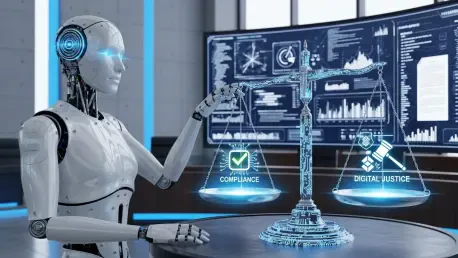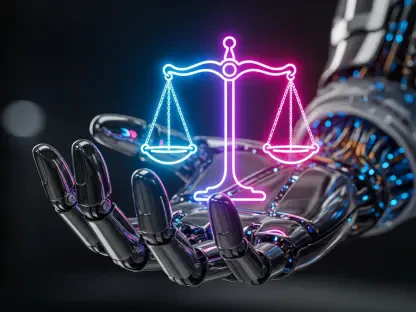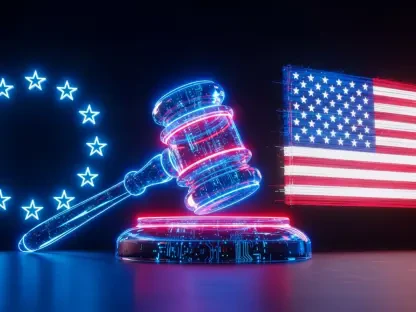Imagine a compliance officer in a fast-growing biotech firm, drowning in a sea of manual tasks like vendor onboarding and policy updates, while facing the constant threat of regulatory missteps that could cost millions in fines or reputational damage. This scenario is all too common in highly regulated industries like pharmaceuticals and biotech, where the stakes are high, and resources are often stretched thin. The emergence of artificial intelligence (AI) offers a lifeline, promising to transform these burdensome processes through automation and real-time insights. This review delves into the capabilities of AI-driven compliance solutions, evaluating their features, performance, and transformative potential in streamlining regulatory adherence and governance.
Understanding AI in Compliance Frameworks
AI-driven compliance solutions leverage advanced algorithms to automate repetitive tasks, analyze vast datasets, and provide real-time monitoring for potential risks. These technologies are built on the principles of machine learning and natural language processing, enabling systems to learn from patterns and improve over time. In industries where regulatory demands are stringent, such as medical devices and biotech, AI steps in to handle labor-intensive processes that once consumed countless hours.
The rise of these tools is a direct response to the growing complexity of global regulations and the need for efficiency amid limited budgets. Compliance teams are under pressure to ensure adherence to ever-evolving standards while managing an increasing volume of third-party relationships and internal policies. AI addresses these challenges by reducing human error and accelerating decision-making, positioning itself as a critical asset in the modern regulatory landscape.
Beyond efficiency, the relevance of AI lies in its ability to adapt to dynamic environments, offering scalable solutions for organizations of all sizes. Its integration into compliance workflows signals a broader shift toward technology-driven governance, where data insights and automation redefine how risks are managed. This sets the stage for a deeper exploration of specific features that make these tools indispensable.
Core Features of AI Compliance Technologies
Streamlining Operations through Automation
One of the standout features of AI-driven compliance tools is their ability to automate manual, time-consuming tasks that often bog down small teams. Processes like third-party vendor management, which involve due diligence on licenses and background checks, can now be completed in minutes rather than hours. For instance, generating presentations for policy updates or summarizing extensive documentation becomes instantaneous with AI assistance.
This automation translates to significant time savings and resource optimization, especially for organizations with limited staff. Compliance officers can redirect their focus to strategic oversight rather than repetitive administrative duties. The impact is particularly pronounced in fast-paced sectors where agility is essential to keep up with regulatory changes and business growth.
Moreover, automation reduces the likelihood of errors that often creep into manual workflows. By standardizing processes and minimizing human intervention in routine tasks, AI ensures consistency and accuracy, bolstering confidence in compliance outcomes. This efficiency is a game-changer for maintaining operational momentum under tight constraints.
Proactive Risk Detection with Real-Time Alerts
Another critical feature is the capacity for continuous monitoring and real-time risk alerts, which empower organizations to stay ahead of potential issues. AI systems can scan vast amounts of data, including media reports and legal databases, to flag risks such as lawsuits or negative publicity tied to vendors or partners. This immediate feedback loop is vital for preemptive action.
Such proactive risk management plays a pivotal role in protecting organizational reputation, particularly in industries where public trust is paramount. Being alerted to a vendor’s legal troubles before they escalate allows compliance teams to mitigate exposure swiftly, ensuring adherence to regulatory standards. This capability transforms risk handling from reactive to preventive.
The precision of these alerts, while not always flawless, provides a foundation for informed decision-making. Even with occasional false positives, the ability to monitor global activities around the clock offers a level of vigilance that manual processes could never achieve. This feature underscores AI’s value in navigating the unpredictable nature of compliance risks.
Evolving Trends and Industry Adoption
The adoption of AI in compliance has surged in recent years, driven by the escalating complexity of regulations in the pharmaceutical and biotech sectors. As organizations grapple with intricate global standards and constrained resources, AI emerges as a tool to manage scale without compromising on governance. This trend reflects a broader push toward digital transformation across regulated industries.
Emerging patterns include a strong focus on integrating AI into secure enterprise systems to address data privacy concerns and mitigate algorithmic risks. There is also a growing emphasis on employee training to ensure responsible use of these tools. Balancing innovation with structured oversight remains a priority as companies navigate the learning curve of AI implementation.
Additionally, industry behavior is shifting toward a more cautious approach, recognizing the need for clear policies to govern AI applications. Over the next few years, from now to 2027, expect increased collaboration between tech providers and regulatory bodies to establish best practices. This evolving landscape highlights the dual need for advancement and accountability in leveraging AI for compliance.
Practical Implementations and Case Studies
AI-driven compliance solutions are already making tangible impacts in real-world settings, particularly in the medical device and biotech fields. At Shockwave Medical, now part of Johnson & Johnson MedTech, AI platforms have revolutionized third-party risk management by automating vendor due diligence and onboarding processes. This enabled a solo compliance officer to handle global operations with unprecedented speed and accuracy.
Similarly, at Vividion Therapeutics, AI tools have been deployed to streamline internal processes like policy updates and administrative organization. By generating presentation materials and summarizing critical communications, the technology has enhanced team accountability and reduced workload pressures. These implementations showcase AI’s versatility in addressing diverse compliance needs.
Such use cases demonstrate how AI empowers teams to manage complex regulatory demands with greater precision. From mitigating reputational risks through continuous monitoring to improving internal workflows, these applications highlight the technology’s role as a force multiplier. The agility gained through AI adoption is reshaping how compliance functions operate in high-stakes environments.
Navigating Challenges and Limitations
Despite its promise, AI in compliance is not without hurdles, particularly in technical accuracy and ethical considerations. False positives and negatives in risk assessments can lead to unnecessary alerts or missed issues, requiring manual validation to ensure reliability. These inaccuracies underscore the importance of human oversight in interpreting AI outputs.
Data security also poses a significant concern, especially when AI tools act autonomously and handle sensitive information. Incidents of unauthorized data distribution during automated processes raise legal and ethical questions, particularly around consent and international data handling laws. Ensuring robust safeguards within enterprise systems is essential to prevent breaches.
Efforts to address these challenges include integrating stronger governance frameworks and prioritizing secure system design. Regulatory hurdles, such as aligning AI use with global compliance standards, further complicate adoption. Ongoing collaboration between technology developers and industry stakeholders aims to refine these tools, balancing innovation with the need for control and transparency.
Future Horizons for AI in Regulatory Compliance
Looking ahead, AI-driven compliance solutions are poised for significant advancements, particularly in algorithm accuracy and predictive analytics. Enhanced capabilities could enable systems to anticipate risks with greater precision, further reducing the burden on compliance teams. Broader integration across regulatory functions is also on the horizon, promising a more cohesive approach to governance.
Potential breakthroughs may include AI systems that not only detect but also suggest mitigation strategies for emerging risks, creating a more proactive compliance ecosystem. Over the long term, these developments could streamline processes to an extent where regulatory adherence becomes a seamless aspect of daily operations in regulated industries.
The societal and industry-wide implications of widespread AI adoption call for standardized policies and ethical guidelines. As these technologies evolve, ensuring fairness and accountability will be critical to their acceptance. The trajectory of AI in compliance suggests a future where efficiency and oversight coexist, provided the right frameworks are established.
Final Thoughts and Next Steps
Reflecting on this evaluation, AI-driven compliance solutions proved to be a powerful ally for pharmaceutical and biotech industries, delivering unmatched efficiency through automation and bolstering governance with real-time risk insights. Their ability to transform manual workloads into streamlined processes stood out as a defining strength, though limitations like data security risks and accuracy issues demanded attention.
Moving forward, organizations should prioritize integrating AI within secure, enterprise-grade systems while investing in employee training to ensure responsible usage. Establishing clear policies to govern AI applications emerged as a critical step to mitigate ethical and legal concerns. Collaboration with regulatory bodies to develop standardized guidelines will also be essential for sustainable progress.
As a next consideration, exploring hybrid models that combine AI capabilities with human expertise could offer the best of both worlds, enhancing decision-making without sacrificing oversight. By focusing on these actionable measures, industries can harness AI’s potential to revolutionize compliance while safeguarding trust and accountability in an ever-evolving regulatory landscape.









